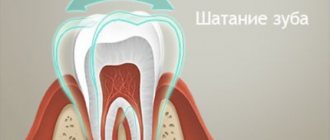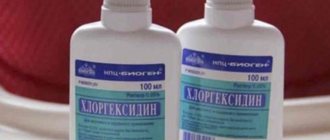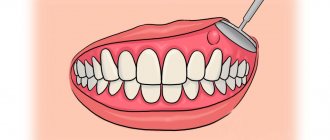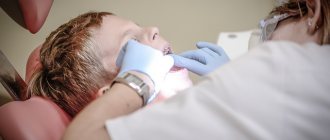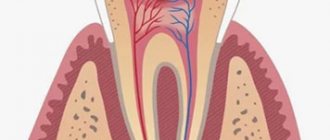Why does swelling occur after dental implantation?
In general, swelling is a completely normal reaction of the body to injuries. All this is nothing more than an influx of lymph to damaged tissues (i.e., accumulation of fluid in a certain area). This way the body’s natural defenses are activated. Swelling forms within 2-3 days - it reaches its peak on the third day after surgery. After this, the swelling of the tissues should gradually decrease and disappear completely within a week.
When installing classic two-piece implants, when the flap method with gum peeling is used, the likelihood of tissue swelling is much higher. Patients with pathologies of the cardiovascular system and diabetes mellitus are also at risk.
Diagnosis of edema
Swelling is detected by pressing a finger on the skin. A sign of excess fluid is a pit that can last for 1–2 minutes. If the blow was to the face or limbs, then attention is paid to the appearance of asymmetry and bruising due to swelling. Sometimes you have to measure the circumference of the joints on the right and left for comparison. Tight skin with loss of turgor confirms the presence of fluid in the underlying layers. The color of the hematoma determines how much time has passed since the injury.
Detailed questioning about the conditions of the injury helps to clarify the diagnosis. A significant sign is redness and an increase in the local temperature of the skin over the damaged area or joint, which indicates the likelihood of inflammation. Differential diagnosis of a bruise is carried out with a sprain or fracture. In addition to swelling, a sprain is characterized by severe loss of mobility and pain. If a fracture is suspected, attention is drawn to: a crunching sensation, deformation of the limb, intense pain. The problem of how to remove swelling from a bruise is dealt with by traumatologists.
How to distinguish normality from pathology
On the one hand, tissue swelling is a normal consequence of the body, on the other hand, this symptom can become a manifestation of an inflammatory process that requires surgical therapy.
If the swelling does not have positive dynamics, that is, does not decrease 3-4 days after installation of the implants, if symptoms such as redness of the gums, monotonous or pain when pressing, increased body temperature, pus that is released from the area around the implant are added - all this speaks of a serious inflammatory process, i.e. peri-implant. And, most likely, implant rejection. If such phenomena occur, you should immediately consult a doctor.
You should also be wary of a situation where the swelling has already subsided, but reappears after some time. This situation again requires immediate consultation with a specialist.
Each patient of the Smile-at-Once clinic is assigned an individual manager, whom you can contact for advice in case of doubt. You will be connected with a doctor by telephone or an appointment will be made for an in-person appointment.
Diagnosis and clinical symptoms
Diagnostic measures for edematous syndrome are not particularly difficult. This condition has certain manifestations, including changes and thickening of the skin. It gets colder or warmer. After pressing, a “dimple” remains, which disappears after a while.
To recognize edematous syndrome, a comprehensive examination is prescribed, which includes:
- serum protein electrophoresis;
- determination of T3 and TA in blood serum;
- liver function tests.
A radioimmunoassay test is also performed to determine TSH in the blood serum. The patient is required to undergo a chest x-ray, electrocardiography and CT scan of the chest. The doctor may order Doppler ultrasound of the veins, cardiac angiography, renal tomography and lymphangiography.
If therapeutic measures have not been taken, then the patient's condition worsens. There is rapid weight gain and thickening of tissues, which in consistency resemble soft dough. The easiest way to diagnose is asymmetrical lymphedema, which is a typical sign, for example, swelling of the arm due to cancer or an increase in the volume of the foot. At the same time, it becomes impossible to gather the skin into a fold.
The clinical picture depends on the affected area:
- Lung cancer
. Accompanied by intense penetration of fluid into nearby tissues. Edema in lung cancer is hidden in nature - the volume of urine decreases and body weight increases slightly. With lung cancer, swelling of the legs occurs and signs such as dryness and excessive peeling of the skin occur. After pressing on the skin of the legs, a small depression appears, which disappears after a short period of time. - Breast cancer
. Accompanied by the development of lymphostasis - difficulty in the outflow of lymphoid fluid. With this complication, the volume of the upper limbs and mammary glands increases. There is a risk of developing irreparable consequences caused by disruption of microcirculation processes. The appearance of trophic ulcers and sepsis (with the development of an infectious disease) is possible. - Liver cancer
. A malignant tumor is accompanied by swelling of the legs and lumbar region, which is associated with damage to the lymph nodes or thrombosis of the inferior vena cava. In this case, rapidly progressing ascites also appears. This is accompanied by an increase in abdominal volume and intra-abdominal pressure. The patient's condition worsens and characteristic shortness of breath occurs.
Legs with cancer may swell when undergoing radiotherapy to the area of the inguinal lymph nodes. Large malignant tumors also block the outflow of lymph, which can lead to its accumulation. The progression of the pathological process leads to cyanosis, in which marble stains appear. The condition is accompanied by severe pain and limitation of motor activity.
Swelling muscles compressing blood vessels cause the development of secondary venous thrombosis. This aggravates the patient's suffering and leads to the migration of thrombotic masses into the pulmonary vessels, which poses a threat of death.
How to reduce swelling after implantation
The main thing you need to do after implantation is to rest well and expect the outcome to be favorable. Your doctor performed the operation successfully, so now how the rehabilitation period goes depends only on you. Read our useful guide after dental implantation, which details what you need to prepare at home in advance and how to solve any problems that arise.
How to apply compresses? This is the most basic method that allows you to relieve tissue swelling. It is especially effective in the first day and even in the first hours after installation of implants.
Proceed as follows: use ice, a heating pad with ice water, or any food from the freezer. But don't overdo it, i.e. do not cause frostbite and tissue necrosis. The procedure is as follows: wrap ice in a towel or 2-3 layers of gauze/thin fabric, apply to the cheek on the side of the surgical intervention, hold for 5-10 minutes. The duration of the compress is 5-10 minutes, breaks are 3-5 minutes. The number of approaches is 7-10 times, for approximately 1.5-2 hours. Such courses can be repeated periodically during the first day.
How to eat properly to avoid swelling? In addition to solid foods (for any implantation protocols, even if the prosthesis was installed immediately), you must exclude excessively hot, spicy and salty foods, coffee, and spices from your diet. Caffeine, for example, increases blood pressure, which contributes to an even greater rush of blood to the head and, accordingly, increased tissue swelling.
Hot foods and drinks are prohibited, as they can lead to increased swelling. Hard - because they can injure the operated area and displace the installed implants. All of the above restrictions are in effect for a week.
Andrey Nikolaevich, 45 years old
“The operation went quickly for me, under anesthesia. I went home fully conscious and without much pain. I expected that when the anesthesia wore off, the pain would be unbearable, there would be severe swelling... Having covered myself with the recommended pills, I waited while I made compresses. The tablets were bought in vain. At night I slept as usual. In the morning I also didn’t experience anything special, there was almost no swelling. On the evening of the first day I came for my first fitting. On the third day, the prosthesis was installed - everything went perfectly!”
“If the doctor is a professional, then rehabilitation will take place very quickly, without pain and without swelling. Tested for myself! "
watch a video with the patient
How should you sleep after implantation? It is necessary to ensure the outflow of blood from the head; it is better to sleep with your head elevated. You can place several pillows under or on the mattress, thus increasing the angle of inclination. Many patients note that after surgery there is a feeling of pulsation in the head. Such a measure will also relieve such a symptom.
Is it possible to visit swimming pools and saunas? To relieve swelling, you need cold. Therefore, not only saunas and swimming pools are prohibited in the first week after installation of implants, but also long stays in a hot bath. It is better to limit yourself to a warm shower.
What medications will help against tissue swelling? After installation of the implants, the patient is prescribed drug therapy. We deliberately do not indicate the names of medications, because in each specific case medications are prescribed individually. But the complex necessarily contains anti-inflammatory and antihistamine drugs, which help reduce tissue swelling. Patients who have problems with the heart and blood vessels, high blood pressure, are also recommended to take appropriate medications.
On the 3rd day after implantation, the patient is scheduled for a preventive examination: the doctor will assess the condition of the tissues, the dynamics of healing and give the necessary recommendations. If you have doubts earlier, you should not wait for a scheduled visit; you can see a doctor earlier.
Let's get rid of hematoma and pain
If after a bruise a bruise on the face or a hematoma with swelling appears, then they usually do not require a visit to the doctor; you can treat and relieve the symptoms yourself. Only a large hematoma requires examination by a specialist; sometimes it is necessary to perform a puncture to remove accumulated blood. After local anesthesia, the wound is opened by a surgeon, then a tight bandage needs to be made. The operation may be performed several times to get rid of the hematoma until the bleeding stops.
To treat a hematoma on the face faster and to avoid pain and swelling, use an anti-inflammatory ointment, cream or gel, for example:
- fastum gel;
- dolobene;
- indovazine;
- long;
- ketonal;
- quickgel
To eliminate pain, you can take an analgesic in the form of tablets (citramon, pentalgin, solpadeine).
Why does numbness occur after dental implantation?
The first hours after dental implantation, anesthesia continues to be active, especially if it was about installing several implants at once. As a rule, a conduction method is used, which ensures blocking of nerve endings for up to 5-6 hours. But the implantation procedure itself takes no more than 2-3 hours, so after it, numbness can actually persist: in some patients - for a couple of hours, in others - up to 5-6 hours. In both cases, this is the norm, and the duration of anesthesia depends on the condition of the body.
Slight numbness of facial tissues can persist for 2-3 days - it is inextricably linked with swelling. But if sensitivity is not restored, you should consult a doctor. The causes of this condition may be damage to the facial or jaw nerve: the sooner treatment is started, the higher the chance of completely restoring tissue sensitivity.
Read more about what facial neuralgia is as a complication after dental implantation >>>
Swelling and numbness are the body’s natural reaction to the “invasion” of a foreign body, that is, an implant. Take a mini-vacation from work for 3-4 days, try to lead a more measured pace of life, give up business trips and important business meetings - give your body rest, because it needs strength to recover. If you want to reduce the risks of any consequences and complications to zero, try to carefully approach the issue of dental implantation, trust your doctor and follow all his recommendations.
Classification
Quincke's edema in 80% of patients is associated with an allergic reaction to foreign substances. But in the practice of doctors there are also other forms of this disease. Depending on the duration of symptoms, there are two types:
- acute angioedema – occurs quickly after contact with the allergen, disappears after treatment and does not recur if you follow the doctor’s recommendations;
- chronic angioedema – signs of pathology recur periodically over 6 months or persist for a long time.
Separately, idiopathic angioedema is distinguished. It appears suddenly; it is impossible to determine the connection with the allergen in the laboratory. This type of disease is chronic and often recurs.
Quincke's edema can be hereditary or acquired. In the first case, it is a chronic disease, the development of which is difficult to predict. It can appear at an early age. Symptoms often worsen in stressful situations. Research shows that this can be triggered by:
- acute pain;
- eating certain foods;
- hypothermia;
- viral infections;
- pregnancy.
Sometimes minor injuries in the oral cavity during dental treatment or tongue piercing act as a provoking factor.
Acquired angioedema develops under conditions that lead to a lack of inhibin C1 protein. This process is activated in patients who are treated with drugs from the group of ACE inhibitors. Protein suppression occurs in neoplastic diseases - B-cell lymphoma, pathology of immune complexes. In an autoimmune disease, the pathology of immune complexes to inhibin protein C1 produces antibodies that block its functions. A similar process is observed in autoimmune diseases - systemic lupus erythematosus, dermatomyositis.
Acquired angioedema manifests itself in old age, when a person has a large number of concomitant pathologies.
Traditional methods
Herbal decoctions, which are used in the form of lotions and compresses, will help relieve swelling from a bruise at home. The folk method is easily applicable at home, and has only one contraindication - increased skin sensitivity. To prepare a decoction for edema, you need to steam a tablespoon of dry raw materials in a glass of boiling water for 2 hours. On the first day, the liquid is pre-cooled; on the second, a warm compress is applied for several hours. Healers recommend herbs:
- plantain;
- sagebrush;
- yarrow;
- St. John's wort.
In case of injuries to the arms and legs, the pain is relieved by warm baths with salt and herbal decoctions.
To combat post-traumatic pain and swelling, they offer recipes from natural remedies:
- bandage a softened cabbage or plantain leaf, change it 2 times a day;
- lotions made from chilled tea leaves are especially recommended for hematomas on the facial skin;
- a mixture of honey and aloe juice in the form of a compress;
- mix equal amounts of iodine tincture, apple cider vinegar and salt, apply by rubbing into the skin for first aid;
- potato juice in lotions is useful for relieving facial swelling;
- a compress of potatoes and baked onions is recommended at night;
- paraffin applications provide long-lasting moderate warmth;
- Rubbing essential oils (eucalyptus, peppermint) into the skin over swelling is useful to combine with massage.
You cannot apply compresses if the skin at the site of the bruise is damaged by abrasions or abscesses. Before starting self-treatment, the wound should be shown to a doctor.
How long does swelling last after a bruise?
In order for swelling on the skin to disappear, it is necessary to restore cells at the site of the bruise (regeneration), strengthen the work of the local network of venules and lymphatic capillaries to absorb and remove fluid into the bloodstream, and dissolve blood clots. These processes are individual for each person. Depends on:
- places of injury (finger, joint, foot, face);
- area of damage and swelling;
- immunity (cells accumulate in the lesion and “restore order”);
- the regulatory role of the nervous and endocrine systems;
- timeliness of treatment.
In people with chronic diseases, swelling lasts longer. For moderately severe symptoms without dysfunction, it is removed after 3–5 days. If the bruise is severe with a hematoma, it goes away in 14–30 days.


